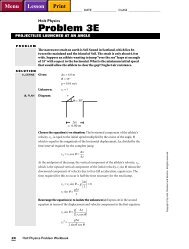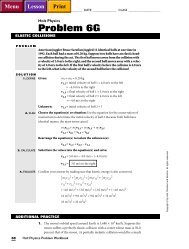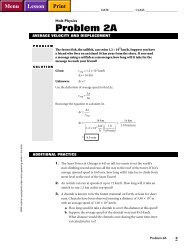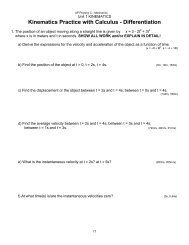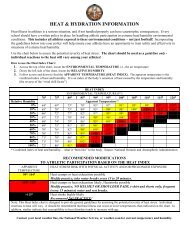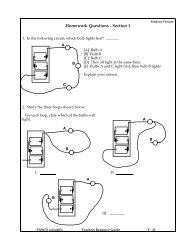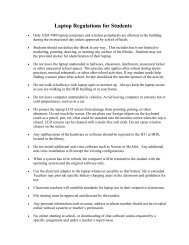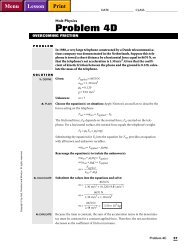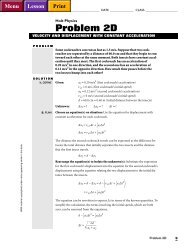Unit 4 homework - Hays High School
Unit 4 homework - Hays High School
Unit 4 homework - Hays High School
You also want an ePaper? Increase the reach of your titles
YUMPU automatically turns print PDFs into web optimized ePapers that Google loves.
Homework Questions – Section 4<br />
Student Version<br />
1. The 10 bulbs, —O— , in each of the following diagrams are all identical. Predict the<br />
relative brightness of each of the bulbs according to the pressure differences indicated<br />
by the colors.<br />
Indicate brightness as one of the following: Very Bright, Bright, Moderate, Dim, Not Lit<br />
Color Difference Brightness<br />
a. red ———O——— green (Example: Bright)<br />
b. yellow ———O——— blue<br />
c. red ———O——— yellow<br />
d. blue ———O——— orange<br />
e. orange ———O——— green<br />
f. orange ———O——— red<br />
g. green ———O——— blue<br />
h. red ———O——— blue<br />
i. orange ———O——— yellow<br />
j. green ———O——— yellow<br />
2. Suppose you have a charged capacitor as in the circuit in Figure 2a, and then you replace<br />
the battery with an uncharged capacitor to obtain the circuit in Figure 2b. What will you<br />
observe when you make this change<br />
R<br />
R<br />
++<br />
++<br />
- - - -<br />
++<br />
++<br />
- - - -<br />
R<br />
Figure 2a Figure 2b<br />
BATTERY AND CHARGED BATTERY REPLACED WITH<br />
CAPACITOR UNCHARGED CAPACITOR<br />
Test your predictions by constructing the actual circuits.<br />
PASCO scientific Teachers Resource Guide T-145<br />
R
3. Begin with two long bulbs, a discharged capacitor and a battery, with a break<br />
somewhere in the circuit. Describe the visible events you would observe following each<br />
change as indicated in the sequence below. The sequence begins when the circuit is<br />
completed and the capacitor begins to charge.<br />
L<br />
L<br />
a. Circuit Connected, Observations:<br />
Charging the Capacitor<br />
L<br />
L<br />
b. Adding a Second Battery Observations:<br />
L<br />
L<br />
c. Adding a Third Battery Observations:<br />
L<br />
L<br />
d. Discharging the Capacitor Observations:<br />
PASCO scientific Teachers Resource Guide T-146
4. Label or color the terminals, plates and wires in each circuit to show the correct color<br />
code (R/O/Y/G/B) for the electric pressures in the following situations. Also, draw<br />
starbursts around each bulb to indicate its brightness if it is lit.<br />
L<br />
L<br />
L<br />
L<br />
L<br />
L<br />
Figure 4a Figure 4b Figure 4c<br />
CAPACITOR UNCHARGED CAPACITOR PARTIALLY CAPACITOR FULLY<br />
(Moment of connection) CHARGED CHARGED<br />
5. Use color-coding to determine the order of brightness of the bulbs in the circuits below.<br />
Rank the three bulbs — “A”, “B”, and “C” — from brightest to dimmest. All seven<br />
bulbs are identical.<br />
A<br />
B<br />
C<br />
BRIGHTEST _________ _________ __________ DIMMEST<br />
6. In terms of electric pressure, describe a “charged capacitor”.<br />
7. In what direction is the conventional flow of charge considered to be ______<br />
a. From low pressure to high pressure<br />
b. From negative to positive<br />
c. From high pressure to low pressure<br />
PASCO scientific Teachers Resource Guide T-147
8. Color-code the circuit diagram below, assuming that the capacitors are fully charged.<br />
The bulbs are identical and the capacitors are identical.<br />
R<br />
R<br />
Based on your diagram, explain how the bulb brightness during charging compares with<br />
the bulb brightness in a similar circuit which contains only ONE capacitor. Test your<br />
reasoning by constructing the circuits and observe.<br />
PASCO scientific Teachers Resource Guide T-148




